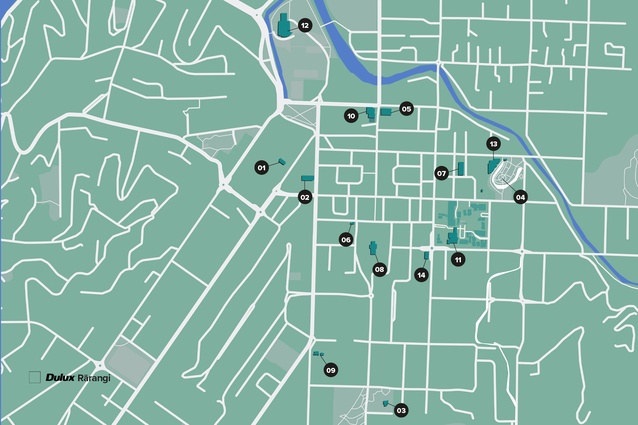Itinerary city guide: Whakatū Nelson
In this Itinerary, supported by Dulux Colours of New Zealand, Andrew Barrie and Donna Luo explore the architectural evolution of Whakatū Nelson, a city set apart by its regional architecture and the promise of easy-living.
Whakatū Nelson has always been a place apart. The city was established in 1841 as the New Zealand Company’s second settlement, positioned in large part because of its natural port. The city’s geography has continued to define its evolution. Like most parts of the country, it has its own history of dodgy land deals and bloodshed, notably the ‘Wairau Affray’ of 1843, in which several of Nelson’s colonial leaders were among a party killed by Ngāti Toa while pushing to survey land that had not been legally purchased. In later years, the region’s favourable climate and natural abundance made it an important centre for horticulture, agriculture and fishery. The promise of easy living also attracted communes, pioneers in pottery and other crafts, and wealthy escapees from the north, with the lingering hippy vibe presumably underlying its recent emergence as a hotbed of anti-vax sentiment.
As in other aspects of history, Nelson’s architectural evolution became a branch somewhat separate from the rest of the country. While it is the same as-the-crow-flies distance from Wellington as is Palmerston North, the connection is no simple road trip or train ride. Nelson does have projects by big city architects, from Frederick de Jersey Clere’s 1901 School of Music to Athfield Architects’ 1998 library at NMIT, but the disconnection meant that, unlike many other provincial centres, where all the plum commissions were scooped up by out-of-towners, the region has supported a sequence of interesting characters and firms.
In the city’s early days, its most prolific architect was William Beatson, described by historian Ian Bowman as the architect who delivered the colonial dream of “the real substance of another England, transplanted on to Nelson’s soil.” Maxwell Bury, best known for designing the early buildings at the University of Otago, also completed important work during several periods of living in the city. In the first half of the 20th century, the leading figures were Arthur Griffin and William Houlker. The city did not always treasure its early architectural gems – fewer than half of the Nelson buildings in John Stacpoole’s Colonial Architecture in New Zealand have survived. The demolition of Bury’s Nelson Provincial Government Buildings in the late 1960s was a galvanising moment in the development of the local preservation movement; the City of Nelson Civic Trust was formed to protect heritage structures.
Through the middle of the century, Alex Bowman was the key player. He was a local who studied and worked in Christchurch and then the UK, returning to deploy a modest but refined modernism. Bowman was joined by fellow modernist George Shing, who had previously practised in Rotorua and was active in Nelson from the 1960s to the 1980s. New approaches emerged in the 1970s with Ian Jack’s late- and post-modernism, and in the 1980s, through Min Hall’s lo-fi but prescient eco-conscious work. The city now has a number of good-sized firms, with Jerram Tocker Barron, Arthouse and Irving Smith operating around the country. These Nelson architects now do more work in the big cities than main-centre firms do in reverse.
The Nelson region has, since the Depression, been a major centre for forestry. Not long after the turn of the millennium, Nelson Pine Industries commissioned the nation’s first laminated veneer lumber plant and, later, XLam began manufacturing cross-laminated timber across town. These unique local capabilities were showcased in the 2011 NMIT Arts and Media building, which received special government funding to become a showcase for the use of timber structure. The project incorporated world-first seismic engineering and all the structural elements were grown, milled and manufactured within an 80km radius. Irving Smith Jack Architects, now Irving Smith Architects, subsequently developed the techniques through a series of commercial projects and collaborations, establishing Nelson’s pre-eminence in the use of mass timber. At a time when we’ve largely given up on regionalism, Nelson has managed to prove that a different way of doing things can be maintained.
THE ITINERARY

01. 1868 – All Saints’ Anglican Church
30a Vanguard Street
William Beatson
William Beatson designed many of Nelson’s most significant heritage buildings, including the Morrison Sclanders & Co. Building (1863; 244 Hardy Street), St Barnabas’ Church (1866; 523 Main Road, Stoke) and Holy Trinity Church (1872; 27 Dorset Street, Richmond). His design for All Saints’ diverged from the Gothic revival style, which settler Anglicans imbued with moral authority, opting instead for Romanesque forms and detailing. William’s son Charles and Antequil Somerville extended the building in various ways through to the 1890s. It has survived numerous catastrophes, with flooding of the grounds at one point so frequent that it was referred to as ‘Noah’s Ark’.
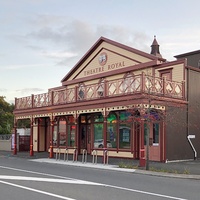
02. 1878 – Theatre Royal
78 Rutherford Street
Bethwaite & Robertson
Designed by local architect William Bethwaite, the Theatre Royal is now the oldest theatre in New Zealand still in operation. It was designed to seat 800 in a town with a population of 6000; 1000 people arrived on its opening night. It continues to be well loved, having survived for more than a century, thanks to continual love and care from the community. On many occasions, the community has fundraised for refurbishments and repairs – including recent restoration work by Palmer & Palmer Architects. It is now a Category 1 historic place and a rare example of surviving Victorian theatre architecture.

03. 1879 – Melrose House
26 Brougham Street
John Scotland
Melrose House was built for Charles Watts, an early settler who arrived in New Zealand at the age of 17 to survey Nelson city and the surrounding area. The house is a fine example of the grand homes built for such early arrivals as they began to prosper in their new country. In 1973, the property was gifted to the Nelson City Council. The Melrose Society was formed the following year to refurbish the house’s interior. Today, the house and five-acre garden is a Category 1 historic place, serving as an events venue and café, open to the public.
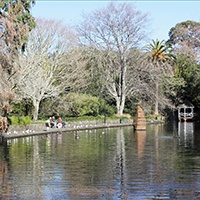
04. 1892 – Queen’s Gardens
Bridge Street
Antequil Somerville
Queen’s Gardens were dedicated in 1887 to commemorate the 50th Jubilee of Queen Victoria. The design, the result of a competition won by local architect Antequil Somerville, incorporated the U-shaped ‘Eel Pond’, a detached bend of the nearby Maitai River. Work then began and the Gardens were formally opened in 1892, with memorial gates and sculptures added over the years. The Gardens include the Category 1 Provincial Fire Engine House (1866), built by Robert McDonald to house the fire engine for the spectacular but now-demolished Provincial Government Buildings, and stylish public toilets completed by Jerram Tocker Barron Architects in 2019.

05. 1936 – State Cinema Building
91 Trafalgar Street
H. Francis Willis
This sleek, buttery slice of art deco was described as a “fine structure” in the Nelson Evening Mail following its grand opening in 1936, and it continues to evoke cinema’s golden era. Hoyts owned it until 1992, when it was purchased by current owner Mark Christensen, who renovated the interior while preserving the iconic façade. It is now a Category 2 historic place. H. Francis Willis was a movie theatre specialist, producing cinemas around the country, though he’s probably best known for the Spanish mission-style New Regent Street Terrace Shops (1932) in Christchurch.

06. 1966 – Bowman’s Building
320 Trafalgar Street
Alex Bowman
Alex Bowman was a key figure in post-war Nelson architecture. He is best known for his houses but this is his most prominent non-residential building – it served as his architectural studio, with retail space on the ground floor. It’s a bit peculiar – what was originally a side lane later became a major street, reconfiguring rear elevations as high-profile street frontages. The interior is beautiful but similarly piecemeal, the light-filled main space seemingly composed of fragmented mid-century elements – large windows, a single truss, skillion roof and chequer-board floor. It was awarded an NZIA Local Award for Enduring Architecture in 2018.
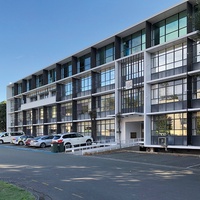
07. 1966 – Monro State Building
190 Bridge Street
Cedric Firth
Cedric Firth is best known for his partnership with modernist hero Ernst Plischke but his high modernist slab confirmed his independent bona fides – this project was a poster child for Kiwi modernism, adorning the cover of Julia Gatley’s landmark Long Live the Modern book. The building has since had brise-soleil inserted into the façade and a floor added on the roof, clouding its purity. The compact government precinct also includes a police station (1961) by the Ministry of Works under Government Architect Fergus Sheppard, following a three-storey design replicated in provincial centres all around the country.
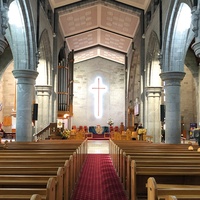
08. 1967 – Christ Church Cathedral
1 Trafalgar Square
Structon Group
The old European cathedrals took centuries to erect, the various sections often reflecting evolving architectural styles. Despite our relatively short history, several Kiwi cathedrals have followed this pattern, including Anglican HQs in Dunedin and Auckland. Nelson had a sequence of timber Anglican cathedrals by maestros Frederick Thatcher (1858) and Benjamin Mountfort (1886). Work started in 1925 on a stone neo-Gothic replacement, to a design by English architect Frank Peck, with the nave completed in 1932. The roof, sanctuary and tower were finally added in international style by Structon Group, its contribution designed in the 1950s and completed in the 1960s.

09. 1967 – Former Rutherford Street Chapel
233 Rutherford Street
George Shing
George Shing was an intriguing but little-known modernist – this is likely to be the first time his name has appeared in this journal. He began his career in Rotorua, where his best-known work is a crisp little office building. He later moved to Nelson, completing a number of larger projects through the 1960s, 1970s and 1980s, of which this is by far the most striking. The building is no longer a church, the lower floor is now a kindergarten, while the worship and support spaces on the upper floor are currently unused.
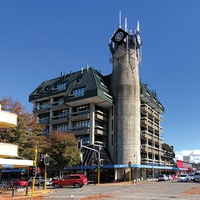
10. 1983 – Civic House
110 Trafalgar Street
Ministry of Works and Athfield Architects
Civic House was designed to replace the earthquake-prone post office building, which had been demolished in 1970. Its use as a post office was short lived, as a result of the Labour Government’s reform and the deregulation of the postal service. In 1991, the Nelson City Council purchased it as its new council building. Since its conception, it has been controversial, subject to many petitions and protests. Architects are presumably keen, the NZIA having bestowed a 2021 Local Award for enduring architecture. The refit of the Customer Service Centre interior is by Jerram Tocker Barron Architects (2009).

11. 2011 – NMIT Arts and Media Building
61 Nile Street
Irving Smith Jack Architects
A landmark in timber design in New Zealand, the project was the winning entry in a government-sponsored competition to encourage the use of structural timber in multi-storey construction. The design met dual ambitions to provide flexible teaching spaces while incorporating University of Canterbury research that led to the world’s first use of seismic, posttensioned timber shear walls. Generous glazing exhibits the art-making and teaching taking place within, while the building itself serves as an educational tool, setting a precedent for environmentally sensitive timber construction. The project won a stack of national and international awards, many for its timber and engineering innovations. Refer Architecture NZ May/June 2011.
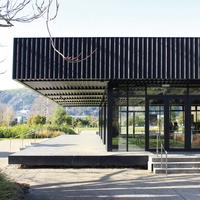
12. 2017 – Trafalgar Centre
Paru Paru Road
Irving Smith Architects
First constructed in 1973 by Alex Bowman, the Trafalgar Centre has since undergone much work, including a southern extension by Arthouse Architects in 2009, and the northern extension and earthquake strengthening completed in 2017 by Irving Smith. The recent extension is an unpretentious but useful foyer and gathering space. Its sensitive placement and generous glazing make the most of the adjacent Rutherford Park and the new 8km Maitai River walkway, which connects the sea, the city and Maitai Valley. The project has won numerous awards, including an NZIA National Award in 2018. Refer Architecture NZ May/June 2018.
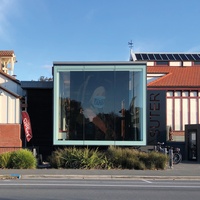
13. 2017 – The Suter Art Gallery
Te Aratoi o Whakatu
208 Bridge Street
Warren and Mahoney, Jerram Tocker Barron Architects and Ian Bowman Architect
Initially constructed in 1899 by Wellington-based Frederick de Jersey Clere in honour of Anglican Bishop Andrew Suter, this is one of the country’s oldest art galleries. As a keen supporter of the arts, Suter wished to provide Nelson city with a gallery, giving both the gallery’s land and artwork from his personal collection. It has since had many extensions and refurbishments, including the 1973 addition of the McKee Gallery. For the 2017 refurbishments, Warren and Mahoney partnered with local firms for seismic strengthening, refurbishments and a major extension. The project received a 2017 NZIA Local Award and a number of other honours.

14. 2019 – Nelson Centre of Musical Arts
48 Nile Street
Irving Smith Architects
The music school was completed by Frederick de Jersey Clere in 1901. The concert chamber has world-class acoustics and became known as one of the best venues for chamber music in the Southern Hemisphere. These acoustics attracted leading national and international performers, and the centre became a vital part of Nelson’s cultural life over the years, now standing as a Category 1 historic place. Alex Bowman added a brick classroom block in the 1970s and, in 2019, Irving Smith completed extensive refurbishments. The studio’s work received numerous national and international accolades, including the Asia-Pacific UNESCO distinction for cultural heritage conservation. Refer Architecture NZ Jan/Feb 2019.
Other addresses
Fairfield House, Atkinson Family (1849) — 48 Van Dieman Street
Former Nelson Institute Building, Antequil Somerville; Arthur Griffin (1884; 1912) — 309 Hardy Street
Marsden House, Houlker and Rix-Trott (1923) — 41 Nile Street
New Zealand Insurance Building, Gummer and Ford (1956) — 204 Hardy Street
Former TNL Office, JASMaD (1978) — 78 Selwyn Place
NMIT Library, Athfield Architects (2000) — 322 Hardy Street
Nelson Airport Terminal, Studio Pacific Architecture (2019) — Trent Drive
Betts Apartments, Arthouse Architects (2019) — 343 Trafalgar Square
SOURCES
The best single book on Nelson architecture is Ian Bowman’s William Beatson: A Colonial Architect (Auckland: Balasoglou Books, 2005), which vividly locates Beatson, his work, and the work of many of his contemporaries in the colonial context. There’s a section on Nelson in Historic Buildings of New Zealand: South Island (Auckland: Methuen, 1983), there are several passages in John Stacpoole’s Colonial Architecture in New Zealand (Wellington: AH & AW Reed, 1976) and a number of Nelson buildings are included in Julia Gatley’s Long Live the Modern: New Zealand’s New Architecture, 1904–1984 (Auckland: Auckland University Press, 2008). For individual buildings, have a look also at Gatley’s Athfield Architects (Auckland: Auckland University Press, 2012) and Jasmax, edited by Stephen Stratford (Auckland: New Zealand Architectural Publications Trust, 2007).

The Itinerary series is supported by Dulux Colours of New Zealand. Dulux Colour Specialist Davina Harper has selected a Colours of New Zealand palette based on this itinerary. See the full range and order colour samples here.


